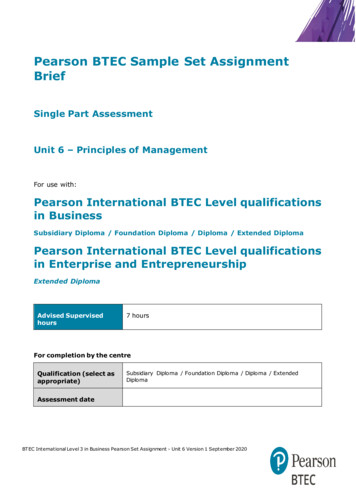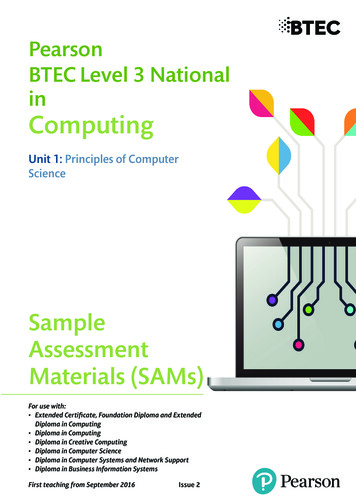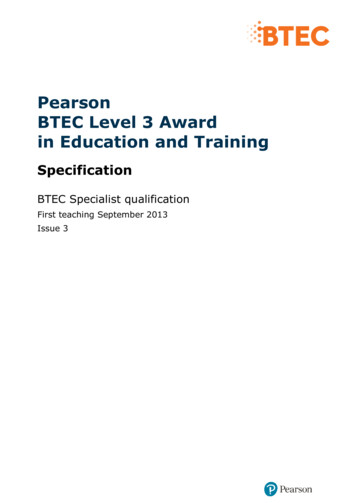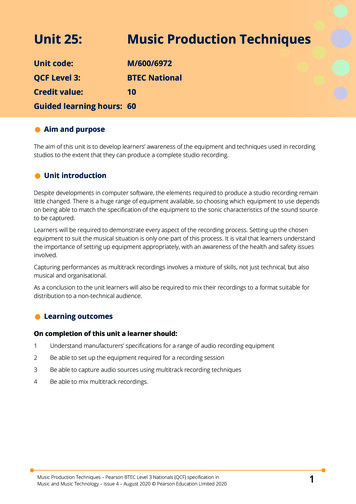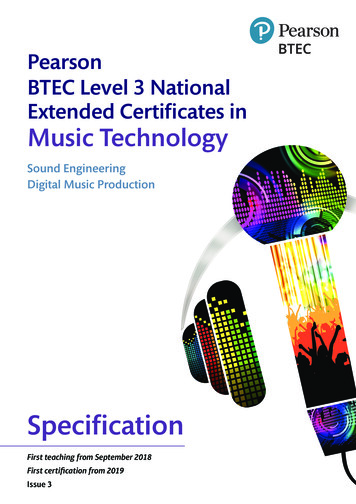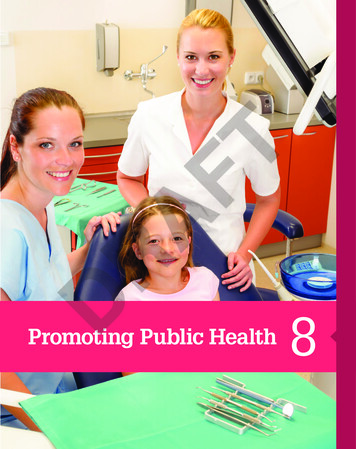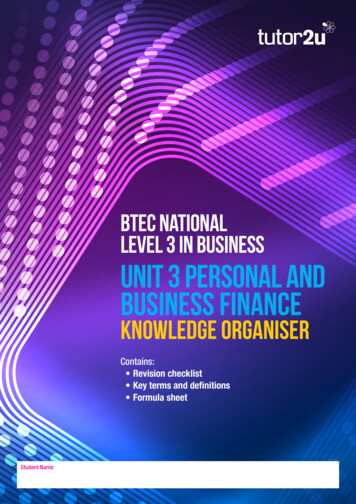
Transcription
BTEC Nationallevel 3 in BusinessUNIT 3 personal andbusiness financeKnowledge OrganiserContains: Revision checklist Key terms and definitions Formula sheetStudent Name:
Revision Checklist Personal FinanceTopicA1 Functions and role of moneyFunctions of money:Unit of accountMeans of exchangeStore of valueLegal tenderRole of money is affected and influence by a number of factors:Personal attitudes towards risk, reward, borrowing, spending & savingLife stages (childhood, adolescence, young adult, middle age, old age), key featuresof each stage, financial needs and implications at each stageCulture, including religious and ethical beliefsLife events can vary the personal life cycle from individual to individualExternal influences/trends and the financial-related effectsInterest rate, cost of borrowing versus reward of savingPlanning expenditure, common principles to be considered in planningpersonal finances:To avoid getting into debtTo control costsAvoid legal action and/or repossessionRemain solventMaintain a good credit ratingAvoid bankruptcyTo manage money to fund purchasesGenerate income and savingsSet financial targets and goalsProvide insurance against loss or illnessCounter the effects of inflationA2 Different ways to payThe use of money as a payment method, advantages and disadvantages of:CashDebit cardCredit cardChequeElectronic transferDirect debitStanding orderPre-paid cardsContactless cardsCharge cardsStore cardsMobile bankingBanker’s Automated Clearing Services (BACS) Faster Payment Service (FPS)Clearing House Automated Payment System (CHAPS)2 BTEC National Level 3 in Business Unit 3 Personal and Business Finance Knowledge OrganiserNotes/coveredHappy/done
TopicNotes/coveredHappy/doneA3 Current AccountsDifferent types, features, advantages and disadvantages, different services offered:StandardPackaged, premiumBasicStudentA4 Managing Personal FinanceSuitability of different financial products and services against individual needs.Different types, features, advantages and disadvantages, different services offered:OverdraftPersonal loansHire purchaseMortgagesCredit cardsPayday loansDifferent types of saving and investment features, advantages and disadvantages:Individual savings accounts (ISAs)Deposit and savings accountsPremium bondsBonds and giltsSharesPensionsRisks and rewards of savings versus investmentDifferent types of insurance products, features, advantages and disadvantages:CarHome and contentsLife assurance and insuranceTravelPetHealthB Explore the personal finance sectorB1 Features of financial institutionsTypes of organisations and their advantages and disadvantages:Bank of EnglandBanksBuilding societiesCredit unionsNational savings and investmentsInsurance companiesPension companiesPawnbrokersPayday loansBTEC National Level 3 in Business Unit 3 Personal and Business Finance Knowledge Organiser 3
TopicNotes/coveredB2 Communicating with customersMethods of interacting with customers, advantages and disadvantages:BranchOnline bankingTelephone bankingMobile bankingPostal bankingB3 Consumer protection in relation to personal financeFunction, role and responsibilities of:Financial Conduct Authority (FCA)Financial Ombudsmen Service (FOS)Financial Services Compensation Scheme (FSCS)Office of Fair Trading (OFT)Legislation – consumer creditB4 Information guidance and adviceFunction, role and responsibilities, advantages and disadvantages of:Citizens AdviceIndependent financial advisor (IFA)Price comparison websitesMoney advice serviceDebt counsellorsIndividual Voluntary Arrangements (IVAs)BankruptcyRevision Checklist Business FinanceC Understanding the purpose of accountingC1 Purpose of accountingRecording transactionsManagement of business (planning, monitoring and controlling)Compliance (preventing fraud, compliance with law and regulations)Measuring performanceControl - assisting with the prevention of fraud, trade receivables andtrade payablesC2 Types of incomeCapital income:LoanMortgagesSharesOwner’s capitalDebentures4 BTEC National Level 3 in Business Unit 3 Personal and Business Finance Knowledge OrganiserHappy/done
TopicNotes/coveredHappy/doneRevenue income:Cash salesCredit salesRent receivedCommission receivedInterest receivedDiscount receivedC3 Types of expenditureCapital expenditure:Non-current assets – tangible (land, buildings and premises, machineryand equipment,vehicles, fixtures and fittings)Intangible (goodwill, patents, trademarks, brand names)Revenue expenditure:InventoryRentRatesHeating and geStationerySalariesWagesMarketingBank chargesInterest paidStraight-line depreciationReducing balance depreciationDiscount allowedD Select and evaluate different sources of financeD1 Sources of financeAdvantages, disadvantages, short-term and long-term:InternalRetained profitNet current assetsSale of assetsExternalOwner’s capitalLoansCrowdfundingMortgagesVenture capitalDebt factoringHire purchaseBTEC National Level 3 in Business Unit 3 Personal and Business Finance Knowledge Organiser 5
TopicLeasingTrade creditGrantsDonationsPeer-to-peer lendingInvoice discountingE Break-even and cash flow forecastsE1 Cash flow forecastsInflows/receiptsCash salesCredit salesLoansCapital introducedSale of assetsBank interest receivedOutflows/paymentsCash purchasesCredit purchasesRentRatesSalariesWagesUtilitiesPurchase of assetsValue Added Tax (VAT)Bank interest paidPrepare, complete, analyse, revise and evaluate cash flowUse of cash flow forecasts for planning, monitoring, control, target settingBenefits and limitations of cash flow forecastsE2 Break-even otal revenueTotal salesSelling price per unitSales in value and/or unitsCalculating using/manipulating break-even formula (units and/or sales value),completion of break-even chart, break-even pointIdentification of area of profit, area of lossIdentify and calculate margin of safety (units and value)Calculation of total contribution, contribution per unit benefits and limitationsUse of break-even for planning, monitoring, control, target settingPrepare, complete, analyse, revise and evaluate break-even6 BTEC National Level 3 in Business Unit 3 Personal and Business Finance Knowledge OrganiserNotes/coveredHappy/done
TopicNotes/coveredHappy/doneF Complete statements of comprehensive income and financial positionand evaluate business performance (Sole Traders)F1 Statement of comprehensive incomePurpose and useCompletion, calculation and amendment to include gross profit (revenue, openinginventories, purchases, closing inventories, cost of goods sold),calculation of profit/lossfor the year (expenses, other income)Adjustments for depreciation (straight-line and reducing balance method)Adjustments for prepayments, accrualsInterpretation, analysis and evaluation of statementsF2 Statement of financial positionPurpose and useCompletion, calculation and amendment of statement using verticalpresentation to include:Non-current assets (tangible and intangible, cost, depreciation and amortisation,net book value)Current assets (inventories, trade receivables, prepayments, bank, cash)Current liabilities (bank overdraft, accruals, trade payables)Net current assets/liabilitiesNon-current liabilities (bank loan and mortgage)Net assetsCapital (opening capital, transfer of profit or loss, drawings, closing capital)Adjustments for straight line (cost x%), depreciation, reducing balance(cost – depreciation to date x%)Adjustments for prepayments and accrualsInterpretation, analysis and evaluation of statementsF3 Measuring profitabilityCalculation, interpretation and analysis of:Gross profit margin: (gross profit/revenue) x 100Mark-up: (gross profit/cost of sales) x 100Profit margin: (profit/revenue) x 100Return on capital employed (ROCE): (profit/capital employed) x 100F4 Measuring liquidityCalculation, interpretation and analysis of:Current ratio: current assets/current liabilitiesLiquid capital ratio: (current assets – inventory)/current liabilitiesF5 Measuring efficiencyCalculation, interpretation and analysis of:zTrade receivable days: (trade receivable/credit sales) x 365Trade payable days: (trade payables/credit purchases) x 365Inventory turnover: (average inventory/cost of sales) x 365F6 Limitations of ratiosLimitations of ratios when assessing business performanceBTEC National Level 3 in Business Unit 3 Personal and Business Finance Knowledge Organiser 7
Key terms Personal FinanceKey TermDefinitionMethods of PaymentCashDebit cardCredit cardChequeElectronic transferDirect debitStanding orderPre-paid cardContactless cardCharge cardStore cardMobile bankingBankersAutomatedClearing Service(BACS) FasterPaymentClearing HouseAutomatedPayment Systems(CHAPS)Notes and coins in a wide range of denominations.Issued by banks with payments for goods and services being deducted directly from a current account.Issued by financial institutions allowing customers to delay payments for goods and services.A written order to a bank to make a specific payment for a specific amount of money from one person’saccount to another account.Payment is transferred directly from one bank account to another.An agreement made with a bank allowing a third party to withdraw money from an account on a set dayto pay for goods or services received e.g. electricity bill.An agreement made with a bank to transfer a fixed sum of money to a third-party account on a set dateon a regular basis e.g. a fixed loan repayment.Money is uploaded onto a card with transactions then withdrawn to reduce the balance.Cards with an embedded chip and antenna that enable consumers to wave their card over a reader atthe point of sale for an automatic transaction.Issued by financial institutions allowing customers to delay payments for goods and services for a shortperiod of time with the balance being paid off in full at each statement date.Issued by a retail outlet to allow customers to delay payments for goods and services – similar to acredit card but only for the store(s) specified.The ability to carry out financial transactions using mobile devices such as phones or tablets.A system that allows the transfer of payments directly from one bank account to another in 3 workingdays (unless faster payment is available).A system that allows the transfer of payments directly from one bank account to another, usually on thesame day.Types of Current AccountsStandardThis type of account provides full day-to-day banking facilities e.g. cheque book, debit card, easy accessto your money and an authorised overdraft facility.Packaged, premium This type of account usually has an annual fee or additional charge in return for offering extra incentives.These benefits can vary but may include offers such as discounted home insurance, no fee overdraft,and premium access to popular event tickets.BasicThis account offers limited features and would be typically held by a person with no credit history inthe UK or a poor credit history.StudentThese are designed to assist young people and students to become prudent with their personal finances.They may come with bonus features, such as interest free overdraft facilities.Types of BorrowingOverdraftPersonal loanHire PurchaseMortgageAllows an individual to withdraw money from a current account that they do not actually have.Allows an individual to borrow a set amount of money which is to be repaid in regular instalments, withinterest.Allows an individual to have use of an item immediately but pay for it in regular instalments. The propertyis only owned by the individual when the final instalment has been paid.A long-term loan to fund the purchase of assets e.g. property which will be repaid over a long periode.g. 25 years.in time and receiving a wage.8 BTEC National Level 3 in Business Unit 3 Personal and Business Finance Knowledge Organiser
Key TermDefinitionCredit cardsAllows an individual to pay for goods or services using a card with a statement issued at the end of eachmonth. The balance can be paid in full without incurring interest, or in smaller amounts with an interestcharge.A short-term source of finance that can help to bridge the gap between the present moment in time andreceiving a wage.Payday loanTypes of Saving and InvestmentIndividual Savingsaccount (ISA)Deposit andsavings accountsPremium bondsBonds and giltsSharesPensionsA tax-free way to save or invest.An account where interest is paid on the balance.A government scheme that allows individuals to save, up to a set amount, in bonds. No interest is earnedbut the bond is placed into a regular draw for cash prizes.These are fixed term securities where the individual lends money to companies and governments inreturn for interest payments.Investments in business in return for equity. The shareholder becomes a part-owner of the business.Long-term savings plans where individuals make regular contributions through their working life. Thisis then repaid upon retirement, either as a lump sum or regular payments.Types of InsuranceCarHome and contentsLife assuranceand insuranceTravelPetHealthTo cover both theft and accidents – there is a legal requirement to insure any car that is on the roadand this protects the driver, passengers and other road users.Home – covers the physical building against events like a fire or flood damage.Contents – covers the physical items inside the house and when they are used away from home.Life assurance – an ongoing policy to pay a lump sum upon death.Life insurance – a policy for a set period of time (e.g. mortgage term) to pay a lump sum if you diewithin that period.Protects individuals or groups while abroad. Cover usually includes illness, loss or theft of property,cancellation and emergencies up to predetermined limits.Protects the owners of pets against some or all of the expenses associated with treating an injured orsick animal e.g. vet fees.Covers individuals, families or employees against medical expenses including assessments, treatmentsand loss of earnings. In the UK, this can pay for private treatment or payment plans for routine visitse.g. to the dentist.Types of Financial InstitutionBank of EnglandBanksBuilding societiesThe UK’s central bank with responsibility for maintaining a healthy level of financial stability for the UKas a whole.An organisation that handles financial transactions and stores money on behalf of its customers.Organisations that handle financial transactions and store money on behalf of their members. Members(account holders) are part-owners of the building society and have a right to vote and receiveinformation on the running of the society.Not-for-profit organisations that handle financial transactions and store money on behalf of their members.Credit unionsNational Savingsand InvestmentA government-backed organisation that offers a secure savings option.Insurance companies Businesses that protect against the risk of loss in return for a premium. They are profit makingorganisations.Pension companies Businesses that sell policies to individuals, whether privately or through employers, to allow them tosave now to fund retirement in the future.PawnbrokersBusinesses or individuals who loan money against the security of a personal asset e.g. an item of jewellery.Payday LoansOrganisations that offer a short-term source of finance to bridge a gap between now and nextreceiving a wage.BTEC National Level 3 in Business Unit 3 Personal and Business Finance Knowledge Organiser 9
Key TermDefinitionMethods of Communication with CustomersBranchOnline bankingA physical place where the customer will visit to carry out transactions.The use of the internet to carry out banking transactions.Telephone bankingThe use of a telephone to carry out banking transactions which may use either an automated service orrequire a customer advisor.The use of mobile devices e.g. mobile phones and tablets, to conduct financial transactions.Mobile bankingProviders of Financial Information and GuidanceCitizens AdviceAn organisation, run by charities, that offers advice on a wide range of issues both financial and nonfinancial.Independent financial Professionals who offer independent advice to their clients on financial matters e.g. savings, mortgagesadvisor (IFA)and mortgages and investments.Price comparisonWebsites that collate prices for similar goods and services within an industry, allowing consumers tositesselect the best deals.Money advice service A government organisation set up to offer free and impartial financial advice in the UK.Debt counsellorsA professional who offers independent advice on how best to manage debt.Individual VoluntaryArrangementsA government organisation that allows an individual to declare themselves bankrupt while agreeing to(IVAs) bankruptcypay all or part of the money they owe to creditors.Key terms Business FinanceThe Purpose of AccountingAccountingAccounting involves the recording of financial transactions, planned or actual, and the use of thesefigures to produce financial information.IncomeIncome is the money coming into a business.Capital incomeCapital income is the money invested by the owners or other investors, used to set up the business orbuy additional equipment e.g. loan, mortgage, shares, owner’s capital, debentures (medium to long-termsources of capital income).Revenue incomeRevenue income is the money that comes into the business from performing its day-to-day function selling goods or providing a service e.g. sales (cash or credit), rent received, commission received,interest received, discount received.ExpenditureExpenditure is the money spent by a business.Capital expenditure Capital expenditure is used to buy capital items, which are assets that will stay in the business for a longperiod of time.Non-current assets Tangible items that will appear on the statement of financial position and include things like land,premises, equipment and vehicles.Intangible assetsCannot be touched but add value to the business e.g. goodwill, patents, trademarks and brand names.Revenue expenditure Spending on items on a day-to-day or regular basis. These expenses are shown on the statement ofcomprehensive income e.g. inventory, rent, rates, heating & lighting, water, insurance, salaries, wages,bank charges, interest paid, depreciation allowance, discount allowed.Sources of Business FinanceRetained profitNet current assetsSale of assetsOwner’s capitalLoansProfit Sales Revenue – Total CostMoney kept in the business to fund future expenditure.Current Assets – Current LiabilitiesShows the money available in the business to fund day-to-day expenditure.Selling an item of value in order to achieve a cash injection.Money invested in the business from the owner’s personal savings.Money borrowed from a financial institution normally for a set period of time and for a specific purpose.10 BTEC National Level 3 in Business Unit 3 Personal and Business Finance Knowledge Organiser
Key TermDefinitionCrowdfundingAttracting investment from a large number of speculative investors, many of whom may invest relativelysmall amounts.MortgagesLong-term loans, normally around 25 years, that are secured against a specific asset e.g. a building.Venture capitalInvestment from an experienced entrepreneur in return for a stake in the business.Debt factoringSelling the debts of a business to a third party in order to receive a quick cash injection.Hire purchasePaying to use an asset in instalments to spread the cost over its useful life.LeasingPaying to use an asset in instalments, however the ownership of the asset remains with the supplierthroughout the lease agreement.Trade creditA period of time, offered by suppliers, to allow the customer to purchase now and pay later.GrantsA lump sum provided to a business by the government or another organisation to be used for a specificpurpose.DonationsSums of money given voluntarily to a charity or social enterprise.Peer-to-peer lending Involves one business lending money to another business person in return for interest payments.Invoice discounting Reductions offered to customers making a product or service cheaper. Usually applied as a percentageof the total value.Break-Even and Cash Flow ForecastsBreak-even analysis Break-even is the point at which a business is not making a profit or a loss. The money received fromsales is the same as the money being spent on costs. Total Revenue Total Costs.Variable costsCosts that change with the level of output e.g. raw materials.Semi-variable costs Part of the cost stays the same and part varies in relation to the degree of business activity e.g. a workerpaid a fixed rate of pay but in addition may receive variable amounts of overtime.Fixed costsCosts that do not vary with output. They remain the same e.g. rent.Total costsTotal costs fixed costs total variable costs.Total revenueThe total amount of money coming in from sales. Total revenue Selling price x quantity sold.Total salesThe amount of sales made in a set time period e.g. one year. It can be expressed as value (monetary)or volume (quantity).Selling price per unit The amount a customer will pay for each unit purchased.Sales in valueSales expressed as a monetary value e.g. Sales in volume (units) Sales expressed as a quantity e.g. units.Cash flow forecast A cash flow forecast tries to predict the cash flowing into and out of a business. A healthy cash flow iscrucial to the survival of a business.Cash inflows/Money coming into the business from various sources e.g. cash sales, credit sales, loans, capital introducedreceiptscapital introduced, sale of assets and bank interest received.Cash outflow/Money going out of a business for various purposes e.g. cash purchases, credit purchases, rent, rates,paymentssalaries, wages, utilities, purchase of assets, VAT and bank interest paid.Opening balanceThe amount of cash available in a business at the end of the start of the month.Closing balanceThe amount of cash available in a business at the end of the month. To calculate: Opening balance net cash flow.LiquidityMeasures a firm’s ability to meet short-term cash payments.Statements of Comprehensive Income and Financial PositionStatement ofcomprehensiveincomeAccrualPrepaymentStatement offinancial positionNon-current assetsCurrent assetsSOCI shows the trading position of the business which is used to calculate gross profit. It then takesinto account all of the expenses to calculate the profit or loss for the year.Accrual is when an expense is paid after the period to which it relates.Prepayment is when an expense is made in advance of the period to which it relates.SOFP provides a snapshot of the net worth of a business at a particular moment in time, normally at theend of the financial year. It is a summary of everything a business owns (assets) and everything it owes(liabilities).Non-current assets are items of value that are owned by the business and likely to be heldfor more than one year e.g. premises and fixtures & fittings.Current assets are items of value that are owned by the business whose value is likely to fluctuate ona regular basis e.g. inventories, trade receivables, prepayments, cash in the bank and cash in hand.BTEC National Level 3 in Business Unit 3 Personal and Business Finance Knowledge Organiser 11
Key TermDefinitionCurrent liabilitiesCurrent liabilities are things owed by the business that must be repaid within a 12-month period e.g.overdrafts, accruals and trade payables.Non-current liabilities are things a business owes that will take longer than one year to repaye.g. mortgages and bank loans.Depreciation is an accounting concept used to spread the cost of an asset over it’s useful life. Assetsappear on the statement of financial position at a realistic value (net book value) and the annualmonthly amount by which the assets are depreciated is included as an expense on the statement ofcomprehensive linedepreciationReducing balancedepreciationAsset is depreciated by a set amount each year.Asset is depreciated by a set % of its remaining value each year. The percentage will be set by asenior account and means that the asset will be depreciated by a lower amount as it ages.Ratio AnalysisGross profit marginMark-upNet profit marginReturn on capitalemployed (ROCE)Current ratioLiquid capital ratioTrade receivabledaysTrade payabledaysInventory turnoverThis ratio looks at gross profit as a percentage of sales turnover.This ratio calculates gross profit as a percentage of the cost of sales.This ratio shows the net profit as a percentage of sales.This ratio shows the percentage return a business is achieving from the capital invested to generatethe return.This ratio shows a business the amount of current assets it owns in relation the amount of currentliabilities it owes.This ratio gives a more accurate reflection of the true liquidity of a business as it removes the leastliquid of all current assets from the equation i.e. inventories.This ratio measures, on average, how long it takes for debtors to pay and is expressed as a numberof days.This ratio shows, on average, how long it takes a firm to pay for goods and services bought on creditand is expressed as a number of days.This ratio shows the average amount of time an item of stock is held by a business and is expressedas a number of days.12 BTEC National Level 3 in Business Unit 3 Personal and Business Finance Knowledge Organiser
Formula SheetSpecification ReferenceFormulaEquationE1 - Cash Flow ForecastsNet cash flowTotal Cash Inflow – Total Cash OutflowClosing balanceOpening balance Net Cash FlowE2 -Break-Even AnalysisTotal revenueTotal costsProfitTotal contributionContribution (per unit)Profit (using contribution)Break-even outputMargin of SafetySelling Price x Quantity SoldFixed costs Total Variable costsTotal revenue – Total costsSales Revenue - Total Variable CostsSelling Price – Variable Cost (per unit)Contribution per unit x margin of safetyTotal Fixed Costs / Unit ContributionActual Sales – Break-even level of outputF1 - Statement ofComprehensive IncomeRevenueGross profitCost of goods soldUnit price x Quantity soldSales Revenue – Cost of Goods SoldOpening Inventory Purchases – ClosingInventoryGross Profit – expenses other incomeCost - DepreciationProfit/loss for the yearNet book valueF2 - Statement ofFinancial PositionNet current assetsNet assetsCurrent Assets - Current LiabilitiesNon-current assets Net current assets Long term liabilitiesCapital employedOpening Capital Profit for the Year lessdrawingsBalance sheet (what needsto balance?)Net Assets Capital EmployedF3 - MeasuringProfitabilityGross profit marginMark-upProfit marginReturn on capitalemployedGross Profit/Revenue x 100Gross Profit/Cost of Sales x 100Profit/Revenue x 100Profit/Capital Employed x 100F4 - Measuring liquidityCurrent ratioLiquid capital ratioTrade receivable daysTrade payable daysCurrent Assets/Current LiabilitiesCurrent Assets - Inventory/Current LiabilitiesTrade Receivables/Credit Sales x365Trade Payables/Credit Purchases x 365F5 - Measuring EfficiencyInventory turnoverAverage Inventory/Cost of Sales x 365BTEC National Level 3 in Business Unit 3 Personal and Business Finance Knowledge Organiser 13
BTEC NATIONAL IN BUSINESSREVISION FLASHCARDSUNIT 3 - PERSONAL AND BUSINESS FINANCEScan the QR code above to order yourUnit 3 flashcards or visit:www.tutor2u.net/business/store
BTEC National Level 3 in Business Unit 3 Personal and Business Finance Knowledge Organiser 7. Key terms Personal Finance Key Term Definition Methods of Payment Cash Notes and coins in a wide range of denominations. Debit card Issued by banks with payments for goods and


